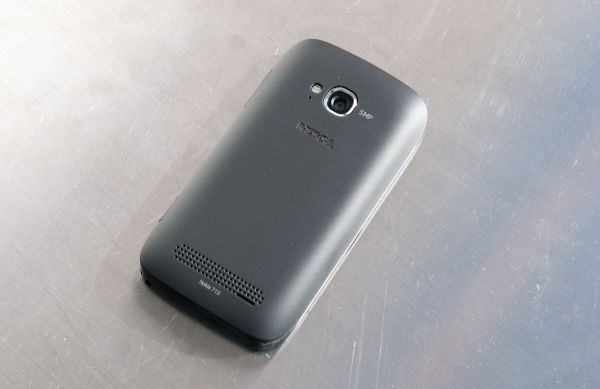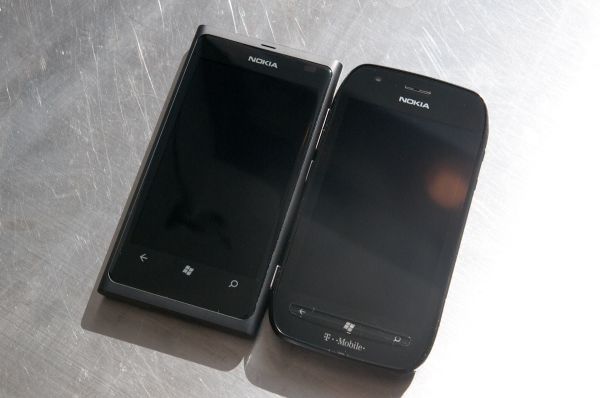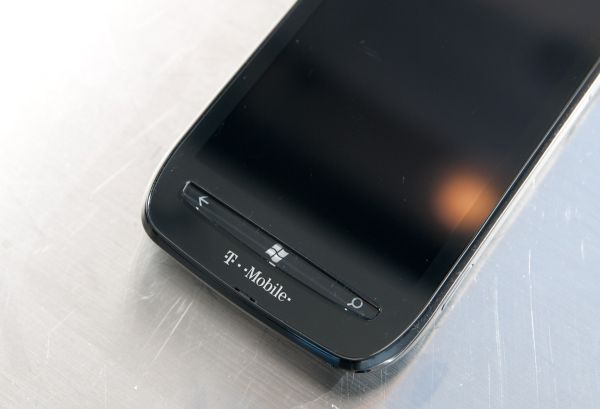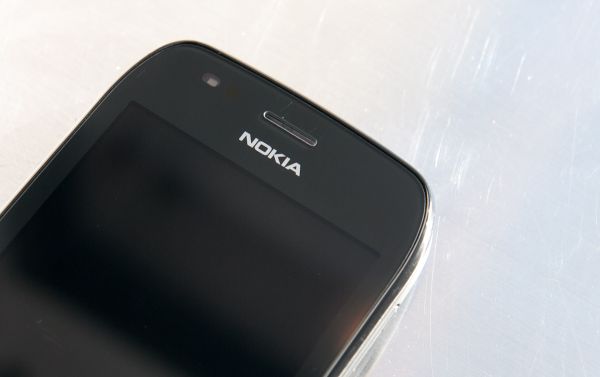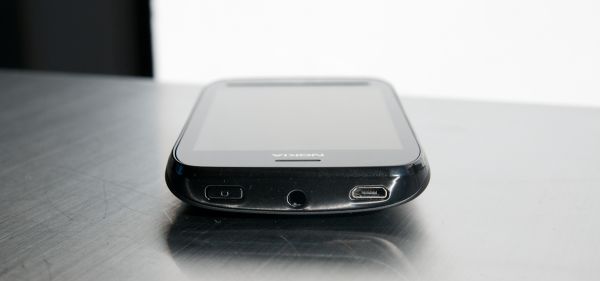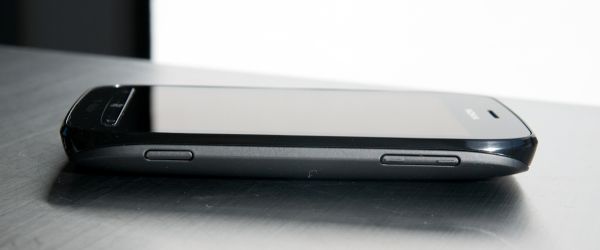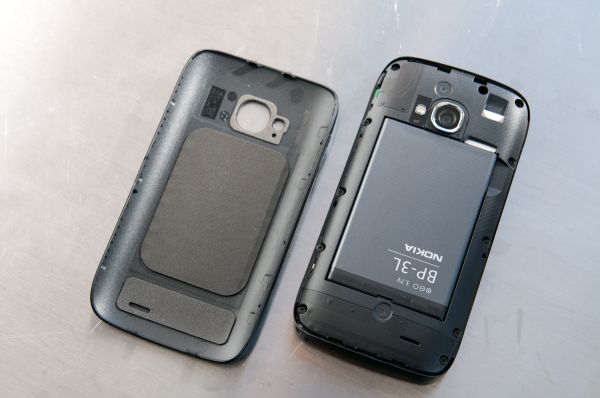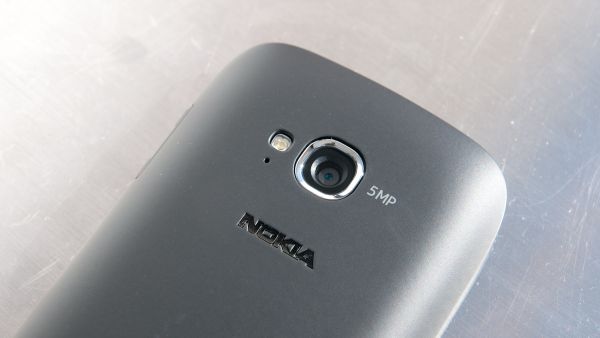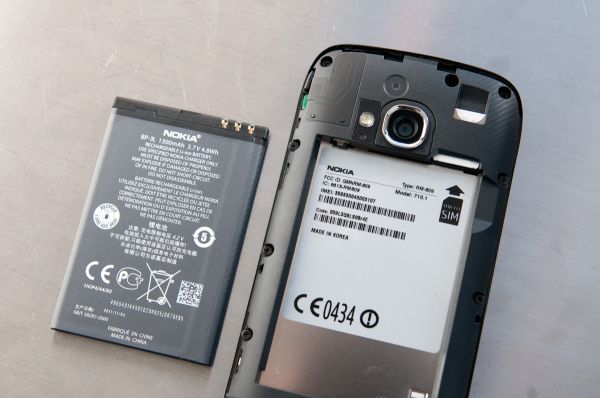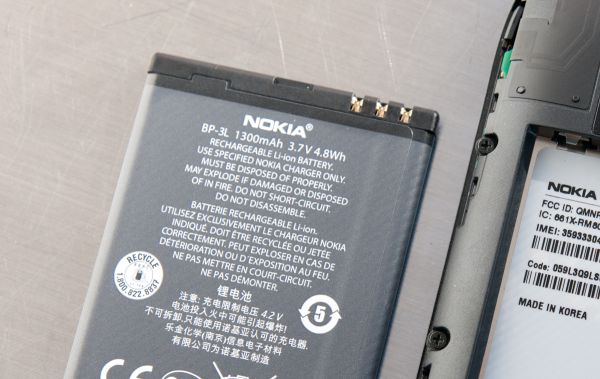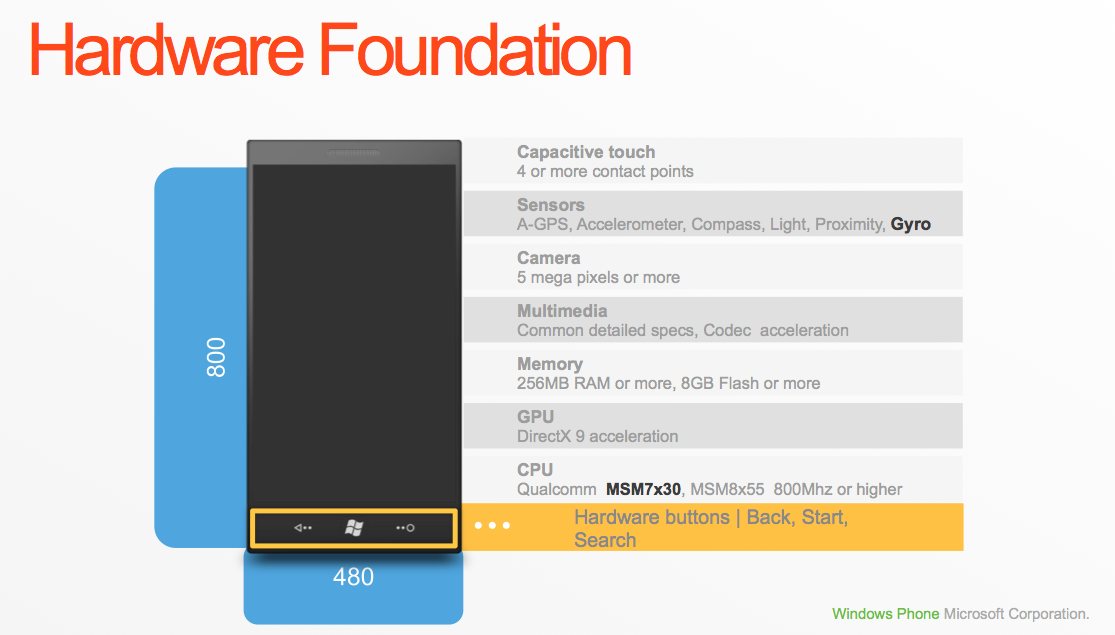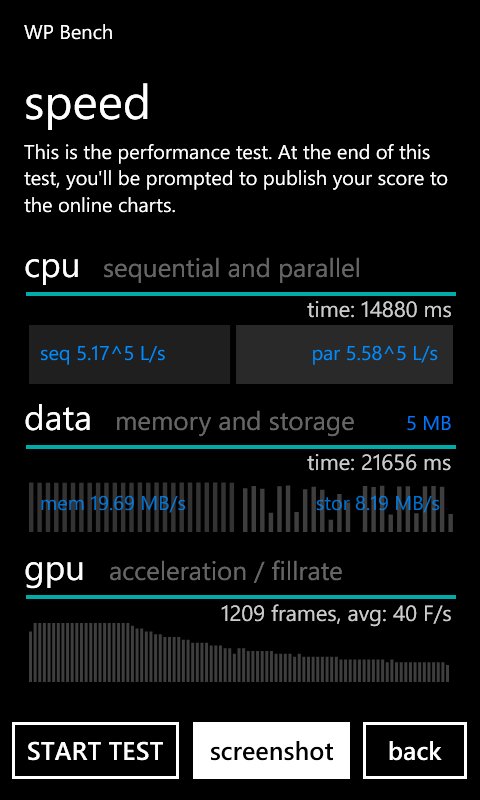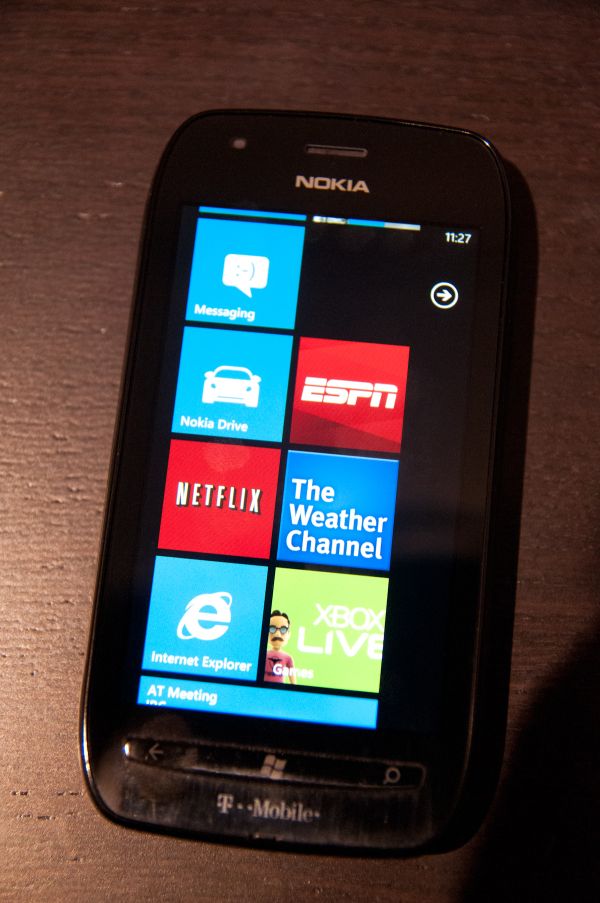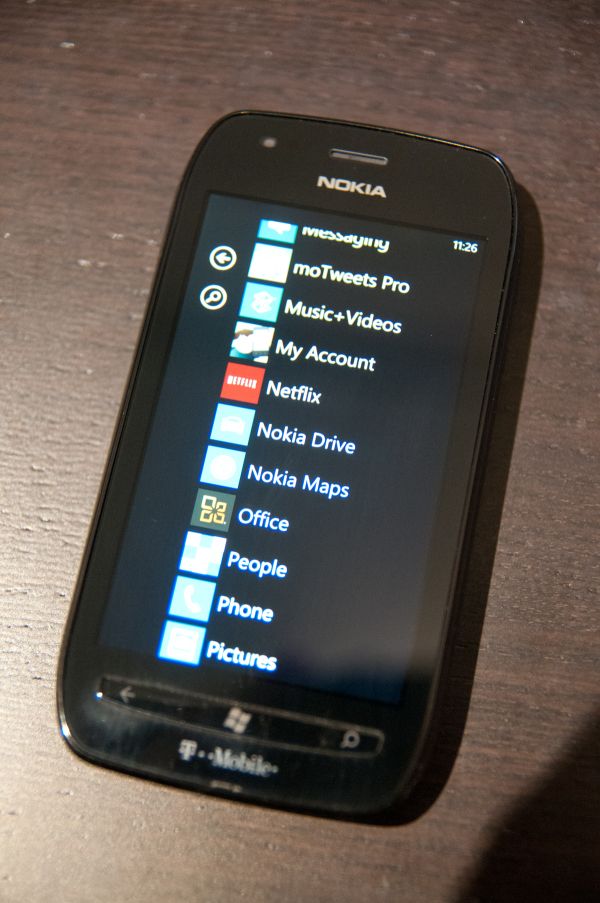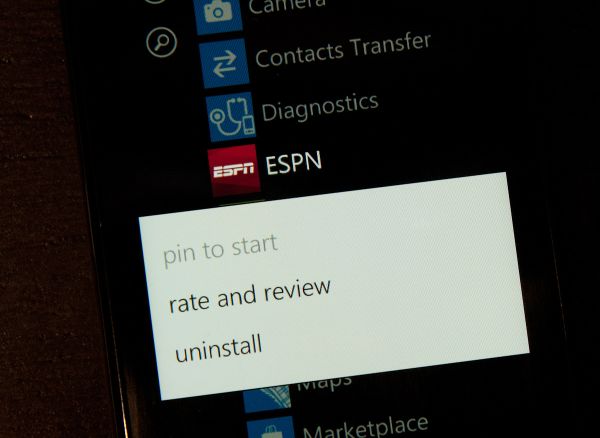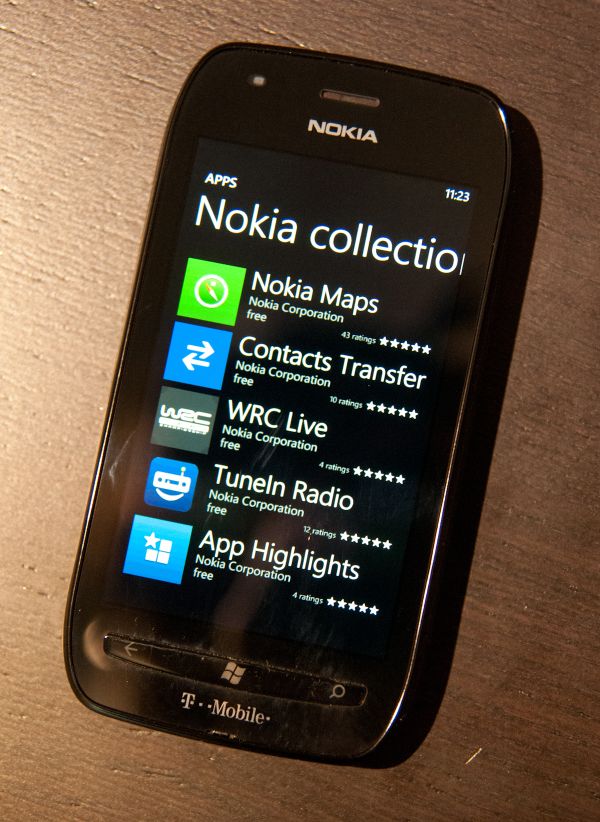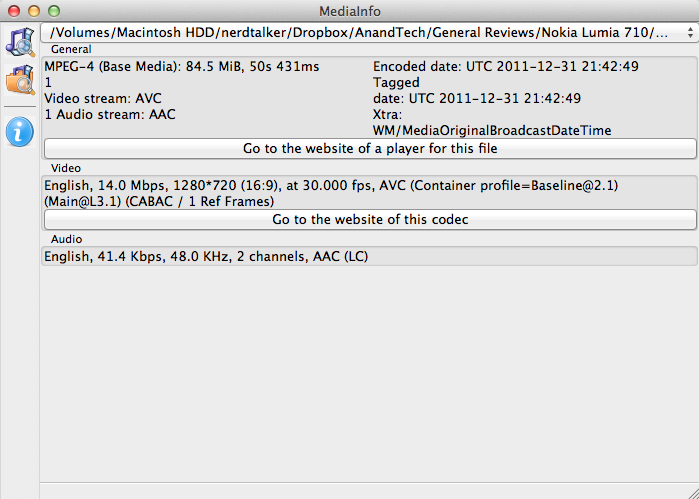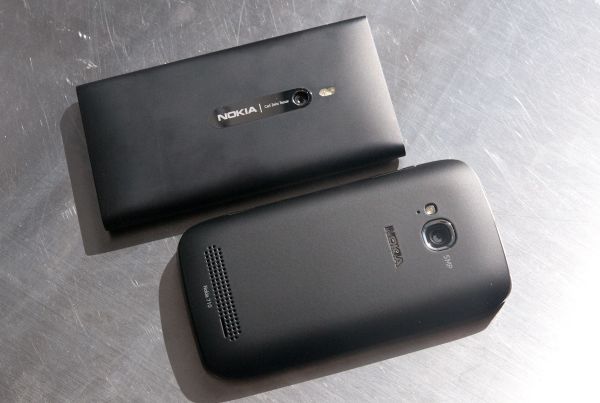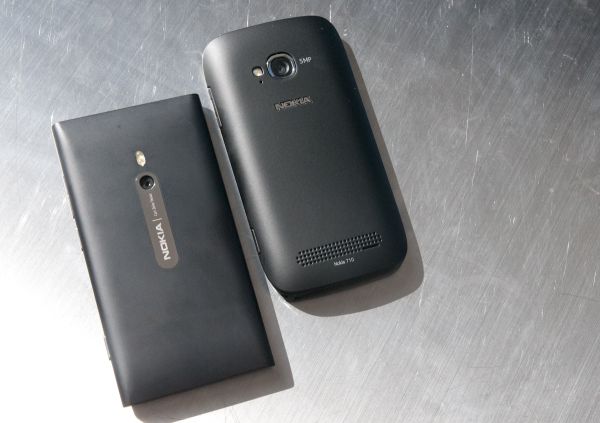
Original Link: https://www.anandtech.com/show/5284/nokia-lumia-710-review-tmobile-nokia-wp7
Nokia Lumia 710 Review - T-Mobile's Nokia WP7
by Brian Klug on January 5, 2012 12:01 AM EST- Posted in
- Nokia
- Smartphones
- Mobile
- WP7
- Lumia 710
Yesterday we took a look at the flagship of Nokia’s Lumia series - the Lumia 800. Today we’re looking at its younger and more entry-level sibling, the Lumia 710. Though the specs are lighter weight and the device isn’t a flagship, Nokia’s expectations for the device are no less high then they were for the Lumia 800, and there’s a lot riding on the 710.
Superficially, the Lumia 710 and 800 are very different. While the 800 is based on the N9’s design with a unibody polymer construction, the 710 is a more traditional device form factor with battery door and removable battery. In the size and weight department, the 710 is actually taller, thicker, and wider than the 800, though more than a half ounce lighter. No doubt some of this is to accommodate the removable battery and door, however it’s surprising how the 710 manages to be larger in almost every way.
The front of the Lumia 710 is one flat and continuous piece of Gorilla Glass. The Windows Phone buttons are of the physical sort, though they are really one continuous plastic button with three pressure sensitive areas that click in. I found using this continuous button somewhat disconcerting at first but easy enough to use after a day or so. The buttons are backlit like they should be, as well.
The only downside to this arrangement is that because the buttons jut out so much, they become the surface that ends up coplanar with a table or desk when the phone is placed face down. As a result, they do pick up scratches if you aren’t careful.
Just below this is a small gap where the primary microphone is located, and at the very top are the usual culprits (earpiece, proximity sensor and ambient light sensor). I don’t believe the glass display has an oleophobic coating either. There’s a small gap in-between the glass edge and plastic around it where dust can gather as well, but it isn’t a hugely big deal.
The Lumia 710 is ringed with a glossy plastic lip that thankfully isn’t chrome but still shows ample fingerprints. At the top and bottom, this lip gets thicker, whereas on the sides it serves primarily for the battery door to snap into. The battery door is a relatively typical black matte soft touch material (I should note that there are multiple body + battery door color combinations of Lumia 710 that will arrive) which doesn’t show fingerprints, thankfully.
The battery door clips onto the right side (where the buttons are) and snaps into place on the left. Nokia thoughtfully also lines the inside region with foam to minimize flex between the door and battery, and also seal out dust that always manages to get inside on other devices. You can also tell that Nokia has been at this for a long while, since there’s no unnecessary extra piece of transparent plastic between the camera module and the battery door.
Nokia’s removable battery is on the smaller side for phones lately at just 4.81 Whr. We’ll talk more about battery performance in the next section, however. The battery compartment is also where the Lumia 710’s microSIM port is, which slides in face down and is held in place by an installed battery. There’s a window at the top where you can get a fingernail inside and push the SIM out. With the backside off, you can also pick out the 710’s cellular antenna (at the bottom) and WLAN/BT antenna (top left) which are pretty standard fare.
On the backside is the 5 MP camera and single LED flash, and just below the flash is the port for the 710’s second microphone. At the very bottom is the speakerphone grille, though only the thin notch in the bottom right actually goes through to the backside.
Next are the buttons - the Lumia 710 places the standby/power button at the very top right, and and the volume rocker and camera buttons in their usual places on the right side. My only complaint is with the camera button. The button is two-step, yet the first detent (for focus and exposure) is impossible to feel on our 710 review unit. Only the second stage which captures is clicky enough to actually be felt.
Just like the Lumia 800, the 710 features a microUSB port and headset jack on the very top. At the very bottom is a cell phone charm/hand strap port.
| Physical Comparison | ||||||
| HTC Sensation | Samsung Focus S | Nokia Lumia 800 | Nokia Lumia 710 | |||
| Height | 126.3 mm (4.97") | 126.1 mm (4.96") | 116.5 mm (4.59") | 119.0 mm (4.69") | ||
| Width | 65.5 mm (2.58") | 66.8 mm (2.63") | 61.2 mm (2.41") | 62.4 mm (2.46") | ||
| Depth | 11.6 mm (0.46") | 8.5 mm (0.33") | 12.1 mm (0.48") | 12.5 mm (0.49") | ||
| Weight | 148 g (5.22 oz) | 125 g (3.9 oz) | 142 g (5.0 oz) | 125.5 g (4.4 oz) | ||
| CPU | 1.2 GHz Dual Core Snapdragon MSM8260 | 1.4 GHz Single Core Snapdragon MSM8255 | 1.4 GHz Single Core Snapdragon MSM8255 | 1.4 GHz Single Core Snapdragon MSM8255 | ||
| GPU | Adreno 220 | Adreno 205 | Adreno 205 | Adreno 205 | ||
| RAM | 768 MB LPDDR2 | 512 MB LPDDR2 | 512 MB LPDDR2 | 512 MB LPDDR2 | ||
| NAND | 4 GB NAND with 8 GB microSD Class 4 preinstalled | 16 GB NAND (no external microSD) | 16 GB NAND (no external microSD) | 8 GB NAND (no external microSD) | ||
| Camera | 8 MP AF/Dual LED flash, VGA front facing | 8 MP AF/LED, 1.3 MP front facing | 8 MP AF/Dual LED Flash, 720p Video Rec. | 5 MP AF/LED Flash, 720p Video Rec. | ||
| Screen | 4.3" 960 x 540 S-LCD | 4.3" 800 x 480 SAMOLED+ | 3.7" 800 x 480 SAMOLED w/ClearBlack | 3.7" 800 x480 TFT LCD w/ClearBlack | ||
| Battery | Removable 5.62 Whr | Removable 6.1 Whr | Internal 5.37 Whr | Removable 4.81 Whr | ||
Internally, the Lumia 710 is nearly the same beast as the Lumia 800. At their core, both are based on a 1.4 GHz Qualcomm single core Snapdragon MSM8255, both have 512 MB of LPDDR2 RAM, and share most of the surrounding chipset. The Lumia 710 also includes 8 GB of NAND of which 6.28 GiB are available to the OS for storage of photos, pictures, music, and videos. Again, the 710 is positioned as more of an entry level device, so we don’t see some of the same expensive extras that really add up.
It’s important to keep some context for the Lumia 710, which in the USA is headed to T-Mobile USA. On T-Mobile USA, the only other current Windows Phone it must compete against is the HTC Radar 4G, which carries similar specifications - 8 GB of NAND, 3.8” WVGA LCD, 5 MP camera, and another MSM8255 but at 1.0 GHz. The Lumia 710 will go on sale on Jan. 11 for $49.99 after a $50 mail-in rebate card on two year contract, which definitely shows how Nokia and T-Mobile intend to position the 710 as a mainstream WP7 platform.
I really have to emphasize that although the super high end devices wind up getting most of the attention and really drive the enthusiast perception of a platform, it’s the mainstream and middle tiers where Android (and now hopefully Windows Phone 7) will make major inroads. That’s something I have to occasionally remind myself about as well; although we have a major tendency to only do deep dives on the absolute bleeding edge hardware, it’s the mid tiers where the platform battles are won and lost.
By most measures, the 710 is a great entry-level device. Its in-hand feel doesn’t feel cheap or flimsy, and at $50 on contract feels a lot better than some of the first generation entry level Android phones I’ve handled but never formally reviewed. The only downside is that the 710 still strikes me as being larger than it really needs to be - there’s no huge battery that it needs to accommodate, nor an absurdly huge display, and yet it still manages to be bigger than the much more fully featured Lumia 800.
Battery Life and Charging
I still believe one of the most important factors for a smartphone is how it fares in battery life testing. We’re going to revamp the entire testing suite in early 2012, but until then, the 710 gets the 2011 treatment like all other devices to date. Those three corners are a series of page loading tests with the display set as close to 200 nits as we can get it on both WiFi, and cellular data (in this case, WCDMA 3G). In the case of Windows Phone, the lack of an analog slider for brightness does force us to use the “HIgh/Medium/Low” presets instead, which can make comparison a challenge. The third corner of our battery life test is a call time test, where we simply place a call between the device under test and another line, and play music at both ends until the battery dies.
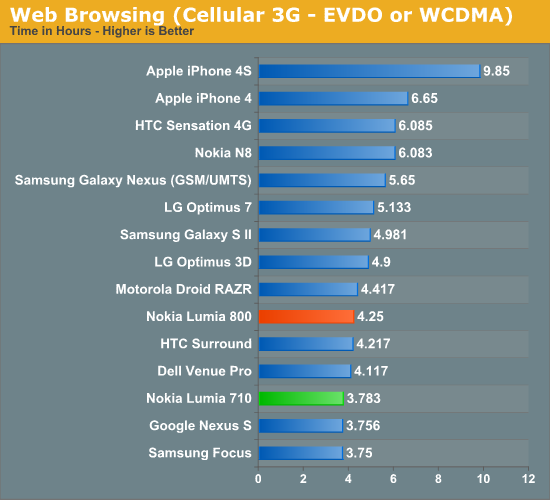
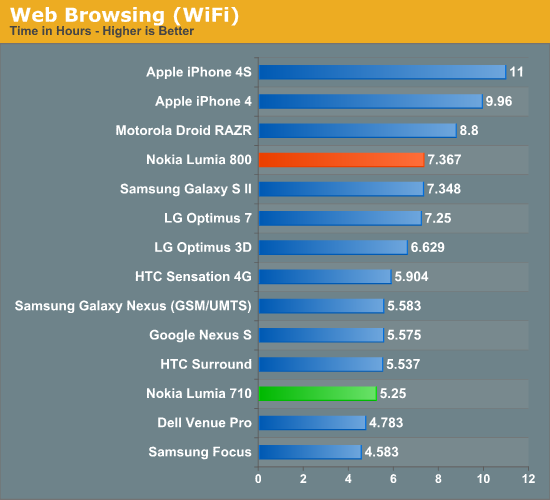
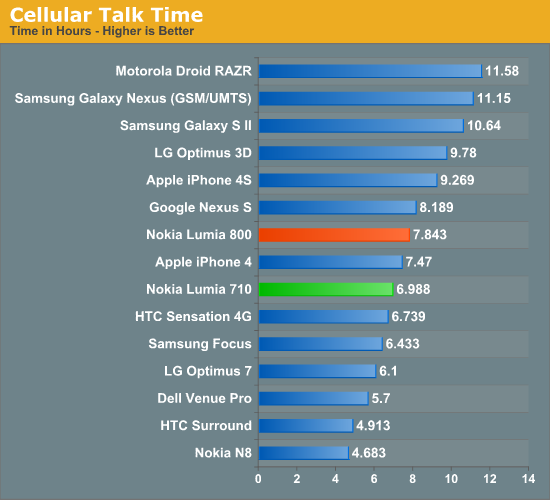
Unfortunately, the Lumia 710’s smaller battery doesn’t do it any favors in our battery testing. On cellular data, the Lumia is indeed ahead of the Focus, and right behind the Venue Pro which we also tested on T-Mobile, but still doesn’t last very long by comparison with some of the other major devices. WiFi page loading also shows a strange little departure from the Lumia’s positive performance, though I can’t verify that the Lumia 710 likewise uses a BCM4329. Call time evens out performance between the two Lumias, but I wager again that we’re just seeing the battery size differences between the two at this point.
On a more positive note, the Lumia 710 doesn’t have any of the charging or battery reporting issues that the Lumia 800 had. The 710 charges speedily enough, and doesn’t get stuck in a pre-boot environment - unable to draw current or charge - like I saw the 800 do when deeply discharged. On that note, the 710 also includes the same diagnostics menu which can be accessed by dialing ##634#, and the interesting/realtime current draw display.
Performance
Unfortunately, the majority of benchmarks that usually grace our smartphone reviews don’t yet have WP7 ports or analogs, but there are a still a number of comparisons we can make. To start, the browser-based performance metrics give a good picture within the Windows Phone ecosystem, and likewise with WPbench, created by one of our own readers and on the marketplace.
This current refresh of WP7 devices continues to be based around exclusively Qualcomm SoCs, and the Lumia 710 is no exception. Both the 710 and 800 are based around Qualcomm’s MSM8255 single core S2 snapdragon at 1.4 GHz with Adreno 205 graphics at the core and dual channel LPDDR2 memory interfaces. This is a 45nm part we’ve seen and explored numerous times before, and as a refresher includes the HSPA+ 14.4 baseband onboard. At this point, there really only are three different SoC and clock configurations which WP7 has to deal with - 1.0 GHz QSD8x50 Snapdragon (65nm single core with Adreno 200 graphics), 800 MHz - 1.0 GHz MSM8x55/MSM7x30 Snapdragon (45nm single core with Adreno 205 graphics), and now a higher clocked 1.4 GHz MSM8x55 Snapdragon.
Those three configurations essentially tell the complete story of Windows Phone’s SoC evolution since launch, which are clearly outlined in their chassis requirements. I spent a paragraph in the Lumia 800 talking about why benchmarking will become even more important in the Windows Phone 7 / Windows 8 ecosystem as this opens up to more SoCs (and ST-E per Nokia’s influence), and how a huge number of benchmark players are busily porting the same Android/iOS benchmarks to the platform. Eventually WP7 will make the jump to dual-core as well.
Anyhow, onward to the numbers. First is sunspider, which we’ve been using for a long while and recently changed from 0.9 to 0.9.1 with. As a result, I’ve had to re-run devices since the numbers aren’t directly comparable. WP7.5 brings a much improved javascript engine which gives it a big boost in scores. I’ve managed to hang onto the HTC Surround (1.0 GHz QSD8250) which we’ve included as well.
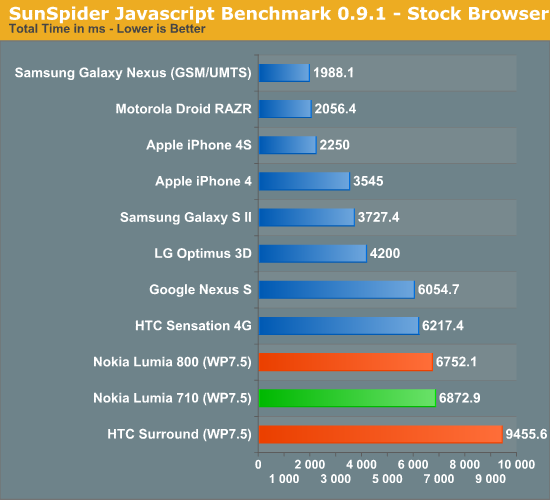
I sound like I’m on repeat, but unsurprisingly we see the same performance we did out of the Lumia 800 (again both are using 1.4 GHz MSM8255) and a big jump thanks to running WP7.5. The new combination of IE9’s Trident 5.0 and Chakra JavaScript JIT engine also helps narrow the gap between iOS and Android in the JavaScript department. Obviously it can’t come close to matching the phones up there with dual core SoCs, however.
Browsermark hasn’t changed or forced us to re-run things, so we have comparison numbers from WP7 devices pre-update that show how much difference there is in the browser department in WP7.5.
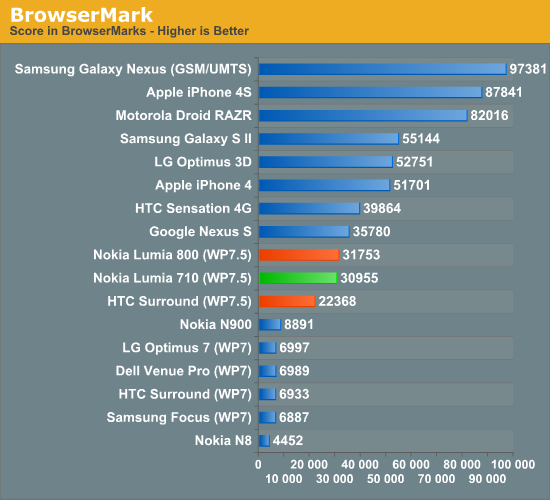
Again here things are almost exactly on par with the Lumia 800, unsurprisingly. Unfortunately if you use the Nexus S (1.0 GHz S5PC110 “Hummingbird” with a Cortex A8 CPU) as a comparison point (vs the 1.4 GHz Scorpion inside MSM8255) you can see how the WP7 team needs to eek some more performance out to bring things totally up to parity. I should note that Nexus S number is for 2.3.6 as well, 4.0.3 puts things even further out of reach.
For system benchmarking on WP7.5 we have WPBench, which was created by one of our own readers. The benchmark reports a total score in addition to three sub-scores for CPU, memory, and GPU.
| WPBench Comparison | |||
| HTC Surround (1.0 GHz QSD8250) | Nokia Lumia 800 (1.4 GHz MSM8255) | Nokia Lumia 710 (1.4 GHz MSM8255) | |
| Total Score | 61.58 | 91.14 | 92.85 |
| Result Screenshot |
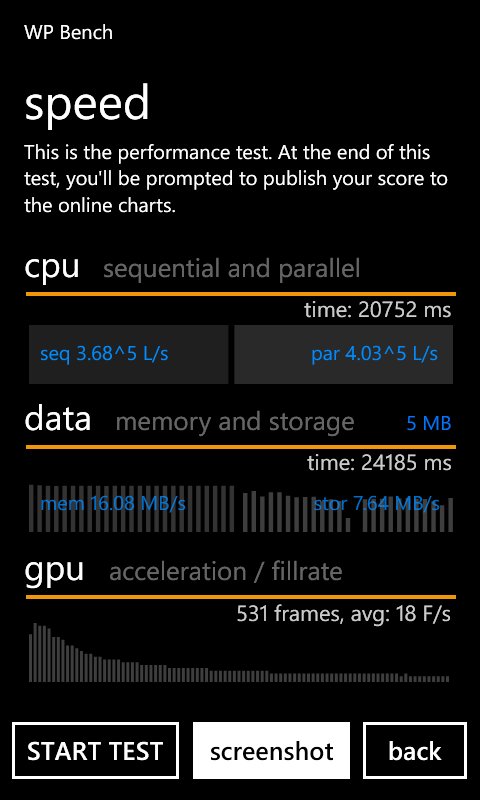 |
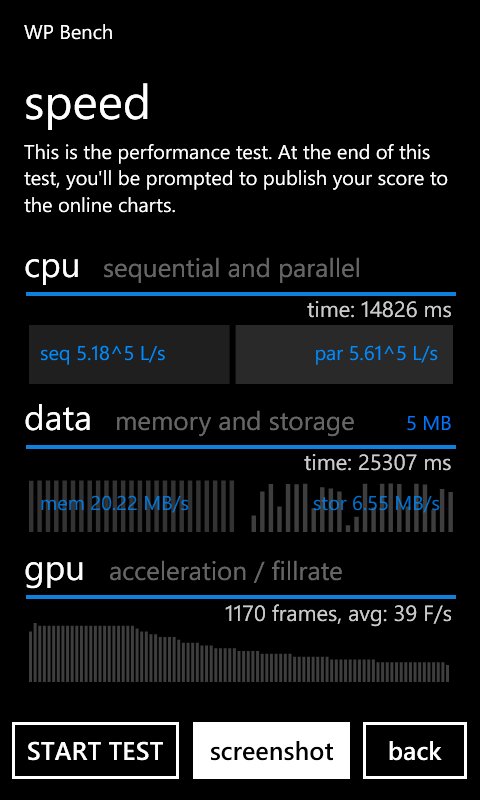 |
|
The rest of WP7.5’s UI in first party applications and the main navigation areas is very smooth, admittedly. It’s here that you really see the reasoning for many people arguing that WP7.5 doesn’t need to make the jump to dual-core very soon. Silverlight applications can occasionally stutter, however, it’s hard to fully codify the differences between first-party (native code) and third-party (Silverlight) performance until we get better tools.
Lumia 710 - Software Preload
The Lumia 710 we were sampled is headed for T-Mobile, and as a result comes with some software preloads. Among those are T-Mobile TV, T-Mobile My Account, TeleNav GPS Nav, Nokia Drive, and an ESPN app.
Thankfully unlike Android 2.x, you aren’t stuck with these preloads for the life of the device or until you root and remove, as WP7 allows for easy uninstallation of any of these preloaded applications.
Obviously T-Mobile My Account is somewhat useful for managing your account information and checking use, but besides the preloaded Nokia applications, I find almost all preloads annoying. Obviously on a device with just 8 GB of NAND keeping this to a minimum is important.
Nokia’s Apps
The Lumia 710 doesn’t come with all of Nokia’s software portfolio installed out of the box, just Nokia Drive. It’s somewhat puzzling that T-Mobile decided to also include TeleNav GPS Nav since Nokia Drive is free on the Lumia series and provides the same turn-by-turn navigation features, but for whatever reason that’s the way things are.
I talked about the Nokia application portfolio in the Lumia 800 review at some length if you’re interested in more details. Suffice it to say that Nokia Drive does a nice job getting the job done, and has gotten more and more speedy with each update since I first saw it. On first launch, Nokia Drive fetches maps and voices over WiFi, so you’ll have to launch this before setting out for some driving.
The interesting thing about the 710 is that the Marketplace application now has a “Nokia Collection” pivot which is home to all the Nokia applications. Maps, Contacts Transfer, and a few others are all present here. Nokia Music and Drive aren’t included here, though Drive is still updated through the marketplace like on the 800. I wager depending on what carrier you’re getting the 710 on, the combination of preload and Nokia preinstalled applications will change.
Obviously the Nokia 710 comes with WP7.5 Mango, specifically build 7740 (7.19.7740.16) on the device we tested.
Camera - Stills and Video
The 710 uses a completely new F/2.4 optical system for Nokia in conjunction with a 5 MP CMOS and rear facing single LED flash. The system has a wide 35mm equivalent focal length of 28mm (and thus the same field of view as the Lumia 800), though it doesn’t carry Carl Zeiss branding.
Camera OSD controls inside WP7 are almost exactly the same as the Lumia 800, which now save and remain persistent across shooting sessions. Those controls are: scenes, white balance, exposure value, ISO, metering mode, effects, contrast, saturation, focus mode, resolution, and flicker reduction. Just like the 800 the 710 offers you the ability to shoot in either 4:3 or 16:9, but doesn’t have the neat ability to accomplish this by not just chopping pixels off the top and bottom. Instead, the 710 shoots at either 5 MP 2592x1944 (4:3) or 4 MP 2592x1458 (16:9) which is really more like 3.7 MP.
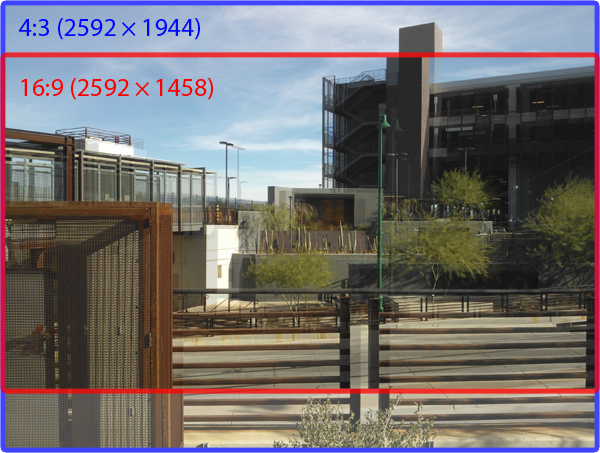
The 710, like every Windows Phone, has a two step camera button, but as I mentioned earlier I found the first detent extremely difficult to locate when pressed. I’m not sure whether this is just a manufacturing errata affecting just my device, or something that will be present on every 710. This does makes shooting difficult since WP7 will capture immediately when the button is pressed all the way down - even if the AF routine isn’t finished. Alternatively you can tap to focus (and capture) which is how I ended up getting most of my camera samples done.
To evaluate the Lumia 710’s camera, we turned to our lightbox tests with the lights on and off, outdoor testing at our test locations, and the new semi-revamped camera tests with the ISO12233, distortion, and color checker charts.
In the lightbox test with the lights on, the camera seems to have some issues (just like the Lumia 800) with white balance, producing an image with a definitely reddish cast. Something about the lights in the lightbox and Qualcomm’s ISP on the MSM8x55 generation of SoC definitely doesn’t get along, since I’ve now seen this behavior across HTC and Nokia devices. I don’t think it’s a fault of WP7 or Nokia after seeing this another time. Sharpness however is good, though I still feel that JPEG compression is turned up too high. For a 5 MP camera however, the 710 doesn’t look bad at all (jot that down as another tick under the 'megapixels don’t matter' column). With the lights turned off, we can see the differences between the white balance (which looks much better here) with the lights on. WP7 nicely fires a pre flash and illuminates the scene while focusing so we don’t miss focus even in the dark, and as a result we get a nice sharp image. The Lumia 710’s flash doesn’t have a super wide angle however, so there’s some falloff at the top and edges.
Turning to the new test bench, we can see some other good behavior out of the 710 camera which isn’t surprising. The white balance on the color checker card is actually not bad, though the colors themselves are a tad undersaturated. The 710 has a bit of barrel distortion (but so does every other smartphone camera) and actually comes out looking pretty good. Having only 5 MP to work with, we obviously see fewer spatial frequencies make it through to the picture in the ISO12233 chart - I can read up to around 12.5 in the saggital and tangential. You can also see that the 710 doesn’t do any insane oversharpening (no halos) here as well.
Next up are the outdoor tests at our smartphone test locations. As a reminder, tests 1 and 2 are no longer available, though 3 through 7 continue to get the job done. Subjectively I think the 710 comes out looking excellent here, with great dynamic range, contrast, and nice and sharp results. Again, my only complaint is that using the physical camera button produced some images where the 710 totally missed focus due to me not being able to tell where the focus detent was at all.
Video
Just like the Lumia 800, the 710 shoots 720p30 H.264 Baseline video at 14.0 Mbps. Audio is stereo AAC at 48 kHz 48 Kbps as well.
The 710 defaults to shooting 720p30 and not VGA, which is excellent. Curiously, the OSD sets the flicker compensation to 50 Hz for a model shipping on T-Mobile, in the US, where our power (and thus flicker from electric lights) is 60 Hz. We do our sample video shooting outdoors however, so this isn’t a huge concern.
Like the other Lumia, I think that the 710 ends up creating excellent quality 720p video. At this point, none of the Windows Phones are shooting 1080p video purely because none of the approved SoCs can encode 1080p video, so you can’t really hold that against the 710. I’ve also done the usual thing and uploaded the video to our own servers (88.6 MB) for you take a look at without any of YouTube’s transcoding.
Display
The 710 uses a 3.7” WVGA LCD display with Nokia’s ClearBlack circular polarizer arrangement and a Gorilla Glass front plate. After looking at the Lumia 800 with SAMOLED and its RGBG PenTile for so long, I actually find the 710’s LCD is a welcome break.
| Lumia 710 Display Metrics | |||
| Brightness Level | Black Brightness (nits) | White Brightness (nits) | White Point (K) |
| High | 0.589 | 526.3 | 6084 |
| Medium | 0.389 | 342.3 | 6038 |
| Low | 0.195 | 175.1 | 5938 |
I put the display through the ringer and measured brightness and white point at the three Windows Phone presets using the Xrite i1D2 as well. White point is a bit on the warmer side, which does subjectively line up with what I perceived just looking at some test images, though it isn’t bad at all. At maximum brightness the 710 is really bright, which is awesome.
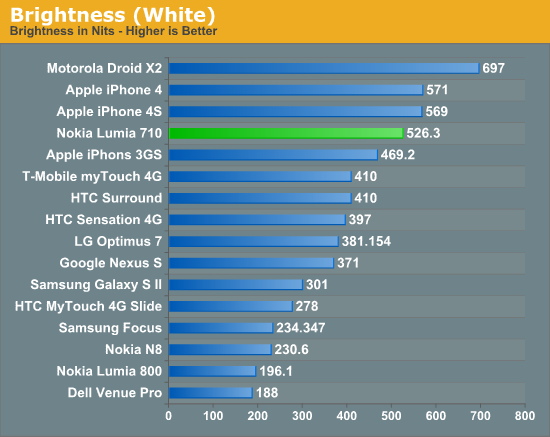
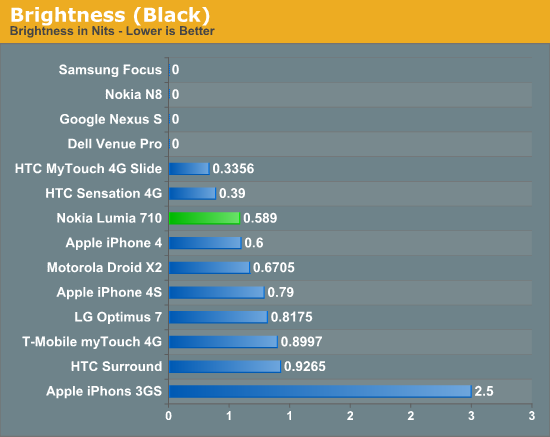
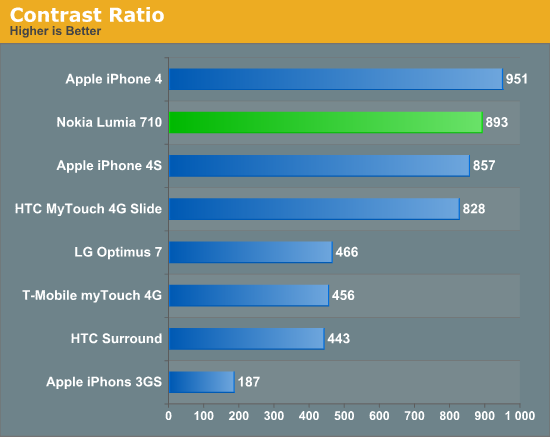
Contrast is also very good on the Lumia 710’s LCD. It’s clear to me that Nokia understands the value of having an excellent display even if it isn’t Super AMOLED, and the 710 shows it. Viewing angles are good, although the 710 does show a bit of color shift if viewed at the most extreme vertical angles. In the horizontal the Lumia 710 doesn’t shift nearly as much, which is good to see.
Outdoors the biggest problem with the 710 is how much it shows fingerprints. I ascribed this earlier on to the device not having an oleophobic coating of some kind. As a result, outside it’s really the fingerprints that occlude clear viewing of the display more than internal reflections which Nokia minimizes with their ClearBlack circular polarizer. I did notice a tiny bit of backlight bleeding at the top in some circumstances as well.
Cellular
Like all MSM8255 devices, the Lumia 710 uses Qualcomm’s onboard combination GSM/EDGE/WCDMA HSPA+ baseband for cellular connectivity. That means HSDPA category 10 on the downlink and HSUPA category 6 on the uplink. Of course, the fact that these HSDPA/HSUPA categories are nothing special at all right now for WCDMA means nothing to T-Mobile, who gladly replaces the “3G” indicator with “4G”.
| Nokia Lumia 710 - Network Support | |||||
| GSM/EDGE Support | 850 / 900 / 1800 / 1900 MHz | ||||
| RM-803 (Europe) WCDMA Support | 900 / 1900 / 2100 MHz (I, II, VIII) | ||||
| RM-809 (T-Mobile USA) WCDMA Support | 850 / 1700 / 1900 / 2100 MHz (I, II, IV, V) | ||||
| Baseband Hardware | QCT MDM8255 w/QTR8615 | ||||
| HSPA+ Categories | HSDPA 14.4 (Cat.10) / HSUPA 5.76 (Cat.6) | ||||
The other noteworthy thing is that the Lumia 710 is also subdivided into two different revisions which carry different WCDMA bands - we were sampled the RM-809 which includes T-Mobile AWS (1700/2100) support. What’s interesting about the RM-809 is that the device also has support for PCS 1900 and Cellular 850, which which means it would work on AT&T, though our device wasn’t unlocked and thus we weren’t able to try. The FCC approval is in place, however. The other Lumia 710 is geared for international support with bands 1, 2, and 8.
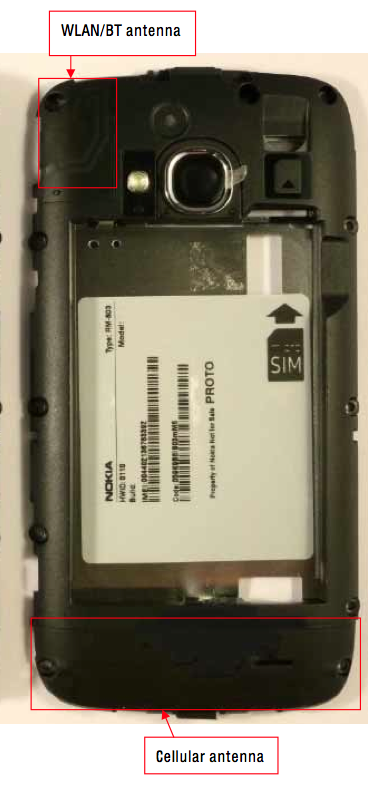
I had no issues at all with the Lumia 710 on cellular - connectivity is excellent. Unfortunately I couldn’t get Field Test on the 710 working to read out dBm and check for deathgrip (for some reason it loads indefinitely), however I didn’t see anything odd in my time with the device. In addition I ran speedtests and saw throughput on par with what I expect out of T-Mobile’s HSPA+, though none of the speedtest applications on WP7 allow me to export data and make a nice histogram or two.
WiFi
WLAN connectivity on the Lumia 710 is the standard fare for almost all smartphones these days - 802.11b/g/n (2.4 GHz) single stream. On 20 MHz WLAN channels, that means a physical rate of 72 Mbps, which is precisely what I saw the Lumia 710 authenticate as. I wasn’t able to completely verify, but it seems like a safe bet that BCM4329 is lurking inside. In addition, range signal performance are spot on with where they should be, I saw no issues in my testing.
In our throughput test I saw speeds that almost matched the Lumia 800 (which isn’t surprising at all).
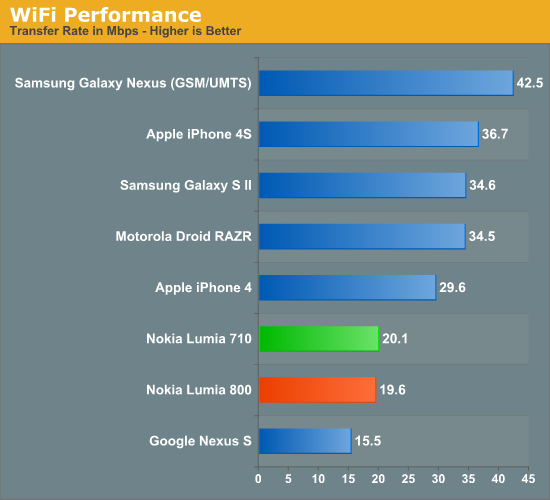
Speakerphone
I spoke a lot about how the Lumia 800’s speakerphone was way too quiet. If the Lumia 800 is one side of the spectrum, the 710 is on the complete other side, as its speakerphone is eardrum-shatteringly loud. In our sound datalogger test, the Lumia 710 placed literally at the top of the ranks for volume, so if you absolutely need speakerphone volume the 710 is an excellent pick. Earpiece volume is also subjectively top notch.
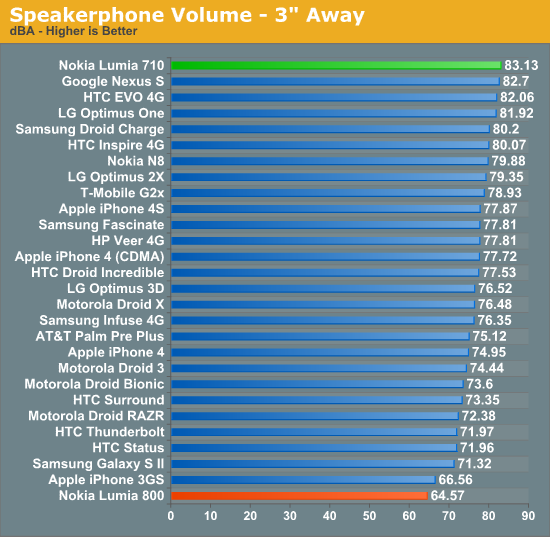
In the call quality department I did the usual thing and recorded samples from the 710 on line in, placed a few calls, and tested noise rejection. The 710, like all WCDMA devices, sounds great to me, though GSM call quality is a bit reduced.
The Lumia 710 does do noise rejection, which has worked its way down from the $200 “superphone” category all the way to the $50 category over the last year or so. The device does common mode noise rejection and some fancy DSP to isolate and cancel noise, and though I’m not sure what IP is in place here (possibly Qualcomm’s Fluence since I don’t see a discrete solution on the board) it does a good job in our test.
GPS
The Lumia 710 unsurprisingly uses the GPS/GLONASS (GNSS) system onboard MSM8255 and accompanied by QTR8615 which we’ve seen numerous times before. Though WP7 doesn’t have API access to NMEA data so we can see SNR from individual satellites, the Lumia 710 does seem to get a GPS lock speedily enough even in some tough environments. In both the maps application and Nokia Drive I had no issues getting a GPS lock in under 5 seconds and keeping the lock for the duration of navigation.
Conclusions
The way the Lumia series is launching in the US is a bit puzzling to me. For all intents and purposes, the 710 is the first Nokia WP7 arriving on US soil, not its higher end brethren, the Lumia 800. Just like I noted with the HP Veer, it’s a daring move to put the midrange product out first, a step ahead of the super high end counterpart. No doubt that high end counterpart is coming at CES in some shape or form (possibly with LTE), but still, a daring move nonetheless. On the other hand, I noted earlier that the midrange is where I wager the volume of the smartphone platform war will be fought and won, and it’s here that WP7 is in a unique position to finally make feature phones obsolete. For $50 after subsidy, you get a device that comes with the same SoC as the other higher-end WP7 devices, a 5 MP camera that produces great photos, and whose only caveat is 8 GB of NAND.
For its first entries into the market as a Microsoft partner, Nokia has done reasonably well. Both the Lumia 800 and 710 are good phones, although neither admittedly has the sort of earth shattering appeal that Microsoft needs to truly win this race. To Nokia's credit however, its partnership with Microsoft was only just announced less than a year ago. Most smartphones are developed on a 12 - 18 month cadence depending on the complexity of the design and the amount of re-use. We won't see what Nokia is truly capable of with Windows Phone until the end of this year at the earliest.
Perhaps that's a good thing as Microsoft still has some work to do on its own. The Mango update to Windows Phone brought about some much needed features, however Microsoft still needs to show that it can deliver substantial updates quicker than the competition as well as embrace new hardware platforms and leverage synergies with other Microsoft platforms. For Microsoft to catch up to Apple/Google's market share it needs to iterate quicker, migrate to faster hardware sooner and truly begin to flex its ecosystem muscle. Break down the barriers between Windows (PC), Windows Phone and the Xbox 360 and Microsoft will have a formidable mobile platform on its hands. I suspect Windows 8 is the start of this, but we need more. If Microsoft can commit to building a world where there's significant overlap between what you can run on your PC, Windows Phone and Xbox 360, I have faith that this platform is destined for great things. I want to be able to play Microsoft published Xbox 360 games on a console connected to a TV, on a Windows 8 PC/tablet or take them with me on a phone.
If, on the other hand, Microsoft doesn't do this - if in two years we don't live in a world where there is mindblowing integration between my Windows PC, my Xbox 360 and my Windows Phone - then the platform deserves to fail. Microsoft will have squandered its biggest advantage.
In conversations with Microsoft the response to all of this is usually a clever smile and a nod. We're usually told that we'll be pleased with what they've got planned. Microsoft has a great hardware partner in Nokia (arguably one of the best in the business) and it has a vast library of content, games and applications that are begging to be ported. Microsoft needs more powerful hardware to pull off some of what we're asking for (ahem, Krait is supposed to be Xbox 360 class at some point, no?) and it needs to execute quickly.
I'm not ready to say that I believe Microsoft will pull this off, but I'm willing to give Microsoft the benefit of the doubt. Microsoft has the ability to choose whether or not this race is already over.

